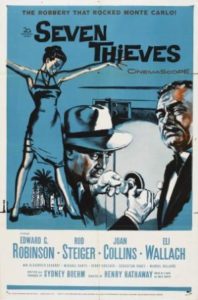If you go to the IMDB page for the 1960 film Seven Thieves, you won’t see much in terms of commentary and reviews. There are less than twenty user review and only a few external reviews. So what gives? Is this schlock to be avoided?
The answer- and those of you familiar with the film will surely echo this- is a definitive no. Featuring a fine cast led by Edward G. Robinson and Rod Steiger and with Joan Collins and Eli Wallach in strong supporting roles, Seven Thieves has a lot going for it.
Robinson is simply “The Professor,” a high intelligent and crafty sort whose been exiled by his peers and family after some trouble with the law. Now out on the free side of the bars he is looking for one final score to make folks gasp with awe just one more time. He’s collected five others already as the movie opens- including Joan Collins and Eli Wallach- but needs “someone he knows” to help him keep them honest.
This last member of the crew is Paul Mason (Rod Steiger, not Orson Welles’ favorite wine), who takes a bit of convincing. He meets the others and finally joins them, but makes his leadership a required condition.
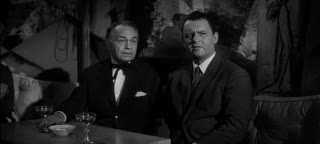 Now fully involved, they set off to the score. The Professor plans to take down a Monte Carlo casino, and with great skill has mapped out the entire sequence of events to make it happen, in many cases down to the minute. Though they are successful in pulling off the heist (think Mission Impossible) and you will have a good feel for it, all of the members have a mid-heist crisis which almost halts things in their tracks.
Now fully involved, they set off to the score. The Professor plans to take down a Monte Carlo casino, and with great skill has mapped out the entire sequence of events to make it happen, in many cases down to the minute. Though they are successful in pulling off the heist (think Mission Impossible) and you will have a good feel for it, all of the members have a mid-heist crisis which almost halts things in their tracks.
Only the Professor keeps things on track with his quick thinking and readiness for any ad hoc changes to plan. Note his quick and effective action when Pancho (Eli Wallach) can’t find the nerve to take his cyanide capsule.
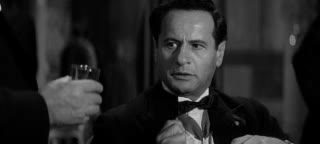 Some have criticized the theft as unimaginative and somewhat clinical in nature. While the latter may be true, the former surely isn’t. The caper is the result of the Professor’s deep analysis of the casino and knowledge of human behavior. What many neglect to note is that the Professor’s recruitment of and mentoring of the team is perhaps the most critical aspect of the plot. If it seems unimaginative it is because he recruited just the right team for the job!
Some have criticized the theft as unimaginative and somewhat clinical in nature. While the latter may be true, the former surely isn’t. The caper is the result of the Professor’s deep analysis of the casino and knowledge of human behavior. What many neglect to note is that the Professor’s recruitment of and mentoring of the team is perhaps the most critical aspect of the plot. If it seems unimaginative it is because he recruited just the right team for the job!
The group falls apart when they learn that the proceeds from the robbery can’t be used. As they bicker and debate, Paul (Steiger) again asserts himself and returns the money, hoping at least the goodwill gesture will prevent prosecution. All ends well as he and Melanie (Collins) win a few francs at the tables and head off to begin their lives together.
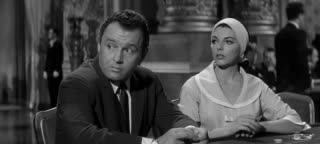 Though I’ve omitted enough of the plot to avoid any big spoilers, you get the drift. Seven Thieves is a well put together film, with excellent pacing under the direction of Henry Hathaway. Though some have labelled it as noir it has little in it which could be termed as that. It’s just a good heist film with a few interesting twists towards the end.
Though I’ve omitted enough of the plot to avoid any big spoilers, you get the drift. Seven Thieves is a well put together film, with excellent pacing under the direction of Henry Hathaway. Though some have labelled it as noir it has little in it which could be termed as that. It’s just a good heist film with a few interesting twists towards the end.
So why is there so little love for Seven Thieves? Though some may be perplexed the answer is pretty simple. Only a few months after Thieves was released, the Rat Pack released Ocean’s 11. On the surface they are almost the same film; but if you’ve seen them both you know they are very different.
For starters, for some odd reason Thieves was filmed in cinemascope, but in black and white. Though the casting and plot of the film is excellent, surely the film had little time to generate great degrees of loyalty before being crushed by the Rat Pack. When compared to Ocean’s 11 it pales in all the superficial categories which we always gravitate too. Edward G. Robinson carried films your father watched, but Sinatra was the star of the new era.
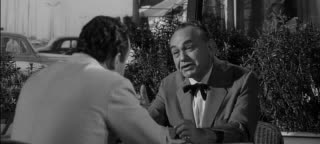 Robinson’s gang is stern, severe, and focused. There is nary a humorous line or situation in Seven Thieves and the focus is on the theft. Ocean’s 11 is fun, full of color and humor. Sinatra’s crew is having fun smoking, drinking and womanizing; their theft is almost an afterthought. Game over for our pals in Monte Carlo as Las Vegas runs them over with a tour bus.
Robinson’s gang is stern, severe, and focused. There is nary a humorous line or situation in Seven Thieves and the focus is on the theft. Ocean’s 11 is fun, full of color and humor. Sinatra’s crew is having fun smoking, drinking and womanizing; their theft is almost an afterthought. Game over for our pals in Monte Carlo as Las Vegas runs them over with a tour bus.
As enjoyable as Robinson and company are, their journey isn’t without its faults. Outside of Edward G. Robinson and Rod Steiger, most of the characters are cardboard cutouts without much to do outside of the checklist they are given for the robbery.
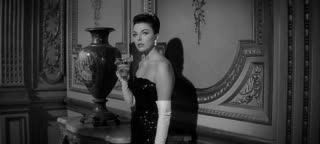 Joan Collins’ introduction in the picture, a cabaret show/striptease in the casino lounge, is disturbing, disjointed and out of place with the tone of the remainder of the picture. Though surely meant to titillate and engage a presumably overwhelmingly male audience, it comes off as simply odd and forced. Her entire lounge performance could just as easily been as a singer, which could have provided the same plot tie-back later on and felt much more in tune with the balance of the picture.
Joan Collins’ introduction in the picture, a cabaret show/striptease in the casino lounge, is disturbing, disjointed and out of place with the tone of the remainder of the picture. Though surely meant to titillate and engage a presumably overwhelmingly male audience, it comes off as simply odd and forced. Her entire lounge performance could just as easily been as a singer, which could have provided the same plot tie-back later on and felt much more in tune with the balance of the picture.
The only other drawback is that onerous decision to film in black and white. Though black and white continues to have its place, by 1960 the expectation at least for feature films was for color. Yes, black and white films were still released on occasion, but almost never in cinemascope. More than the cast- which outside of Robinson is actually pretty contemporary-it is this alone which not only makes the film seem older than it is but also permitted it to be forgotten to the likes of the original Ocean’s 11. And for disclosure, we aren’t rabid fans of 11 in spite of Dean Martin’s participation.
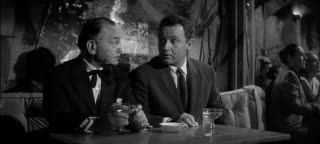 The true allure of the film is Edward G. Robinson himself. Yes, here his is no longer the assertive gangster of the 1930s or the lecturing bather of Key Largo. But now he may be even better in a little quieter (like the real man himself) but just as powerful a performance as he ever gave. It is almost wistful hearing Robinson yearning for that final score- to feel that adrenalin rush just one more time of having the spotlight on him.
The true allure of the film is Edward G. Robinson himself. Yes, here his is no longer the assertive gangster of the 1930s or the lecturing bather of Key Largo. But now he may be even better in a little quieter (like the real man himself) but just as powerful a performance as he ever gave. It is almost wistful hearing Robinson yearning for that final score- to feel that adrenalin rush just one more time of having the spotlight on him.
